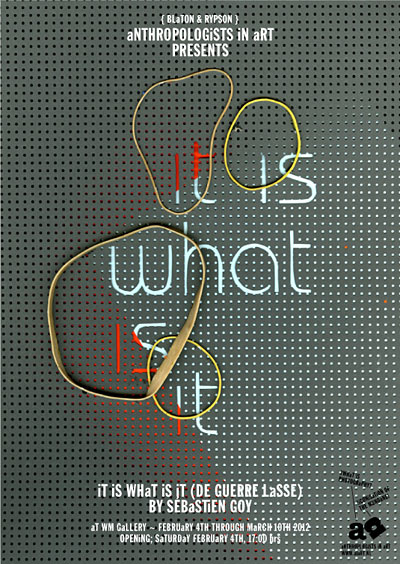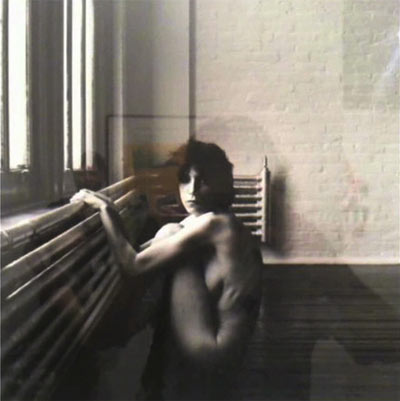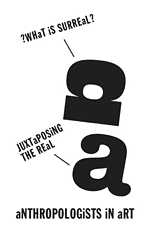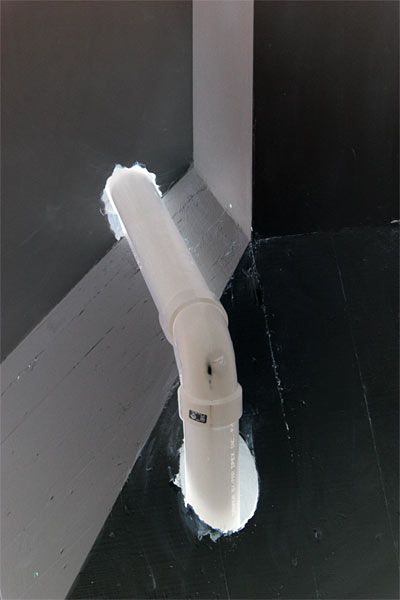|
Urged by the contemporary exhaustion of the image, French artist Sébastien
Goy (1975) explores in his recent works the relationships between
picture and materiality. His video installations suggest possible modes
of coexistence between physical and pictorial spaces, from playful interaction
to melancholic contemplation. “It Is What Is It (De Guerre Lasse)”,
his first solo show, centres this investigation on the tenuous object
of photography.
Walter Benjamin affirmed that the work of art lost its aura with the
advent of photography and the mechanical reproduction it enabled. In turn,
one could lament that photography has lost its aura or be amused to see
the biter bitten. Yet Goy’s pieces are not motivated by nostalgia,
nor by irony. The dialogue photography entertained with the real seems
to have been two long monologues: a plea for faithfulness followed by
a bombastic denial, both convinced of their supremacy. To renew this dialogue,
the artist does not arbitrate but proposes embedding one with the other,
to develop a form of empathy between the parties.
Some pictures are thus given a specific presence, a physicality endangering
their own immateriality, while documentation is alleviated by contemporary
visual techniques: The jitter of a sunset recorded in a car is compensated
so that the sun can be precisely aligned on the edge joining two projection
walls; a few seconds-long shot of a landscape is slowed down to become
an animated drawing of fifteen minutes.
Goy’s practice is informed by a strongly analytical approach. He
operates through work-experiments, which distil the essential elements
of the photographic process: projection, processing and presentation.
Yet the formal exercise is avoided as his artworks lean on a casual photographic
practice — shooting snaps and poaching files, each image retaining
a personal significance. The alliance in his practice of analytical and
casual languages produces what Jorinde B. Seijdel, art historian and critic,
for a previous exhibition described as “a delicate reflection on
today’s technical and philosophical gestation, status and essence
of the image and on our relation to it, how we lose ourselves in it and
find ourselves back.” | |
Aangespoord door de hedendaagse uitputting van het beeld,
onderzoekt de Franse kunstenaar Sebastien Goy (1975)
in zijn recente werken de relatie tussen beeld en materialiteit. Zijn
video-installaties wijzen op mogelijke vormen van co-existentie tussen
fysieke en beeldende ruimtes, van speelse interactie tot melancholische
contemplatie. "It Is What Is It (De Guerre Lasse)",
zijn eerste solo show, richt zich op het broze object van de fotografie.
Walter Benjamin bevestigde dat het kunstwerk haar
aura had verloren met de komst van de fotografie en de mechanische reproductie
die het mogelijk had gemaakt. Op zich, zou men kunnen zich kunnen beklagen
dat fotografie haar aura heeft verloren of geamuseerd zijn dat de hond
zelf is gebeten. Toch zijn Goy’s stukken niet gemotiveerd door nostalgie,
noch door ironie. De dialoog die fotografie heeft gevoerd met het ‘echte’
lijken twee lange monologen te zijn geweest: een pleidooi voor trouwheid,
gevolgd door een bombastische ontkenning, beiden overtuigd van hun suprematie.
Om deze dialoog te vernieuwen, tracht de kunstenaar niet zozeer te bemiddelen,
maar stelt een inbedding van de één met de ander voor, een
vorm van empathie tussen de partijen te ontwikkelen.
Sommige foto's krijgen dus een specifieke aanwezigheid,
een lichamelijkheid die een gevaar voor hun eigen immaterialiteit vormt,
terwijl de documentatie wordt verzacht door hedendaagse beeldende technieken:
Het schuddende van een zonsondergang die in een auto is opgenomen wordt
gecompenseerd zodat de zon nauwkeurig kan worden geprojecteerd op de rand
van twee projectiemuren, een shot van een landschap van een een paar seconden
wordt vertraagd om te verworden tot een geanimeerde tekening van vijftien
minuten.
Goy’s praktijk is geïnformeerd door
een sterk analytische benadering. Hij opereert door middel van werk-experimenten,
die de essentiële elementen van het fotografisch proces destilleren:
projectie, verwerking en presentatie. Toch wordt de formele oefening vermeden
aangezien zijn kunstwerken leunen op een ongedwongen fotografische praktijk
- snapshots schieten en bestanden stropen; elk beeld behoudt een persoonlijke
betekenis. De verbintenis in zijn praktijk tussen de analytische en de
informele taal leidt tot wat Jorinde Seijdel B., kunsthistoricus en criticus,
met betrekking tot een vorige tentoonstelling, omschreef als " Een
delicate reflectie over de hedendaagse technische en filosofische wording,
status en essentie van het beeld en hoe wij daar tegenover staan, ons
erin verliezen en in terugvinden." |



